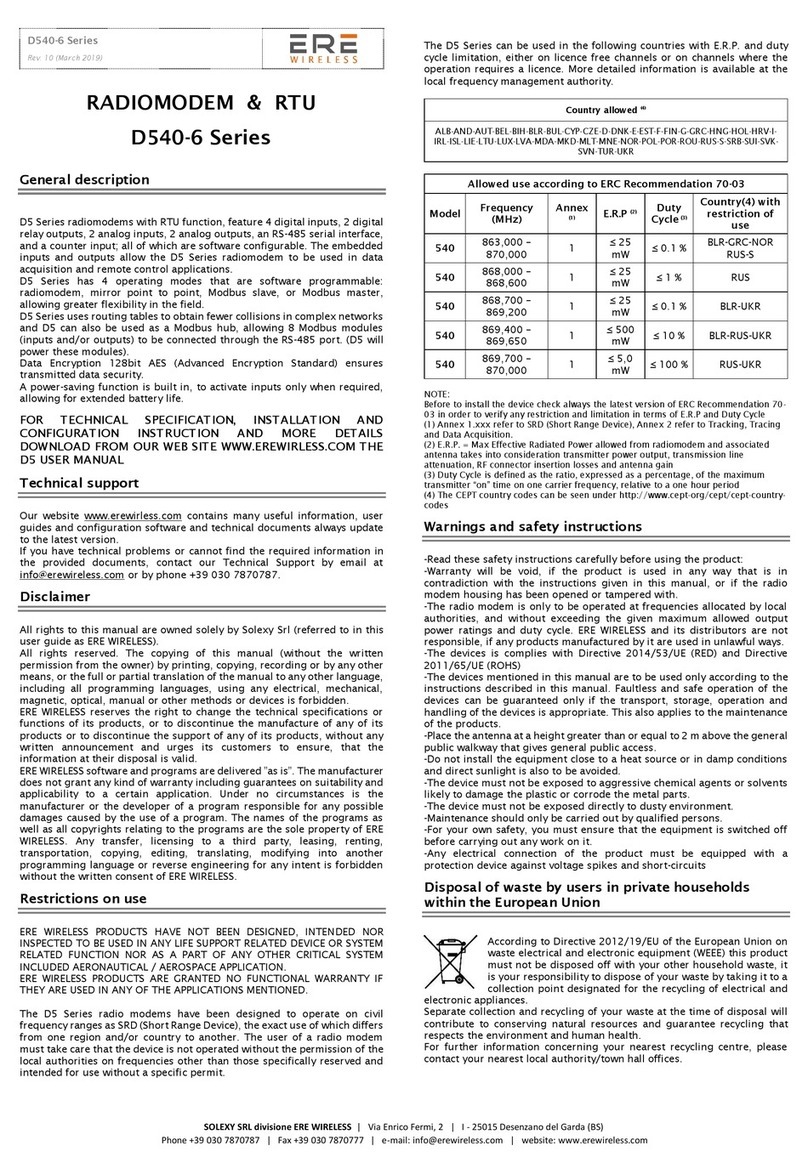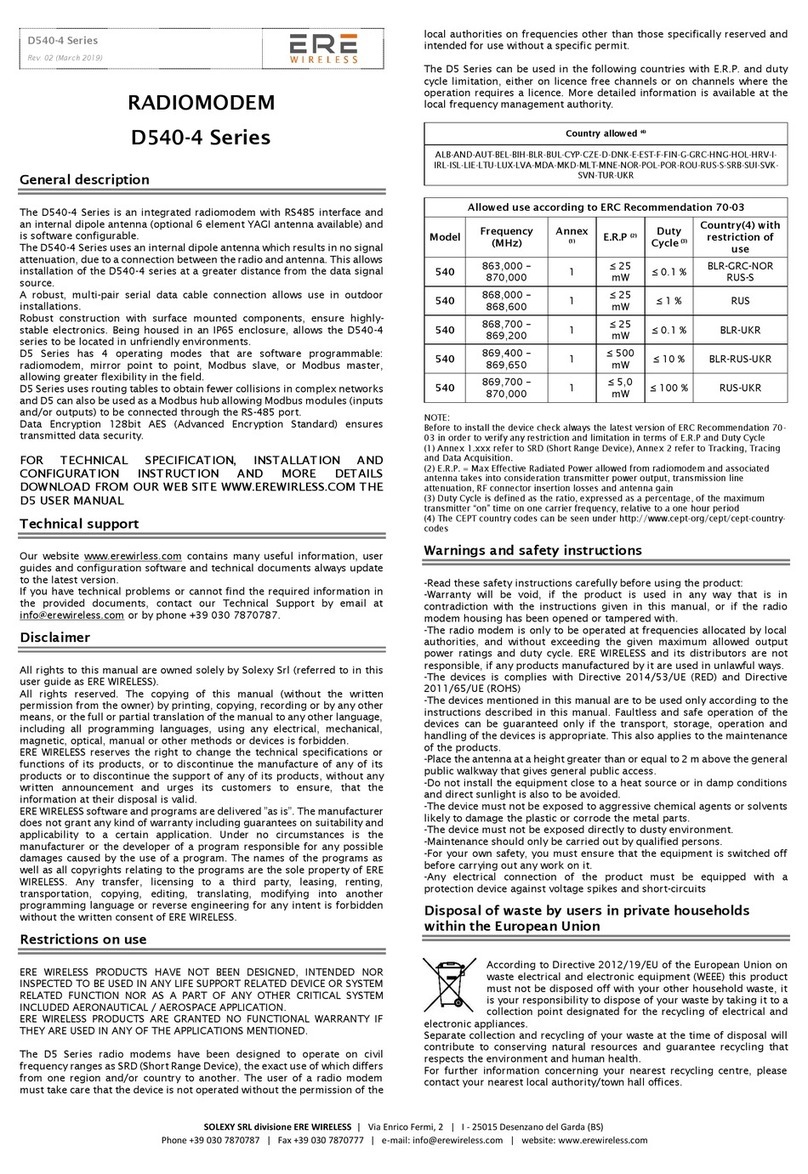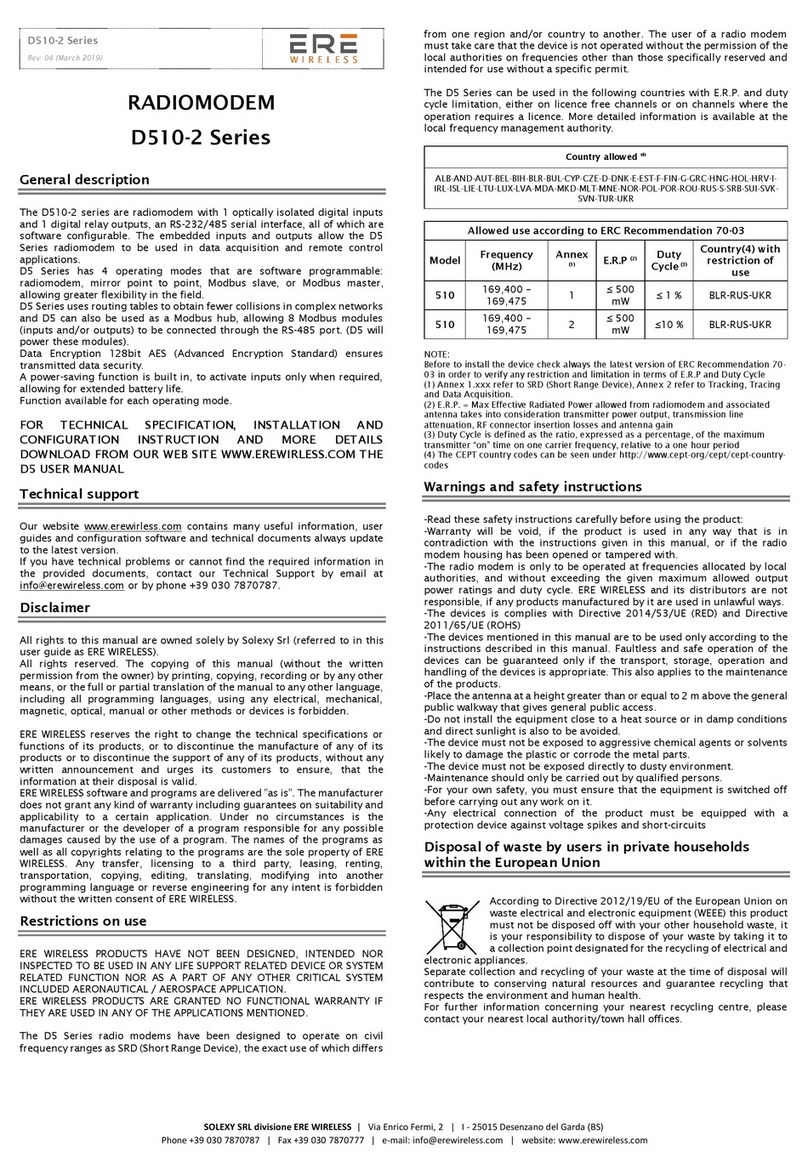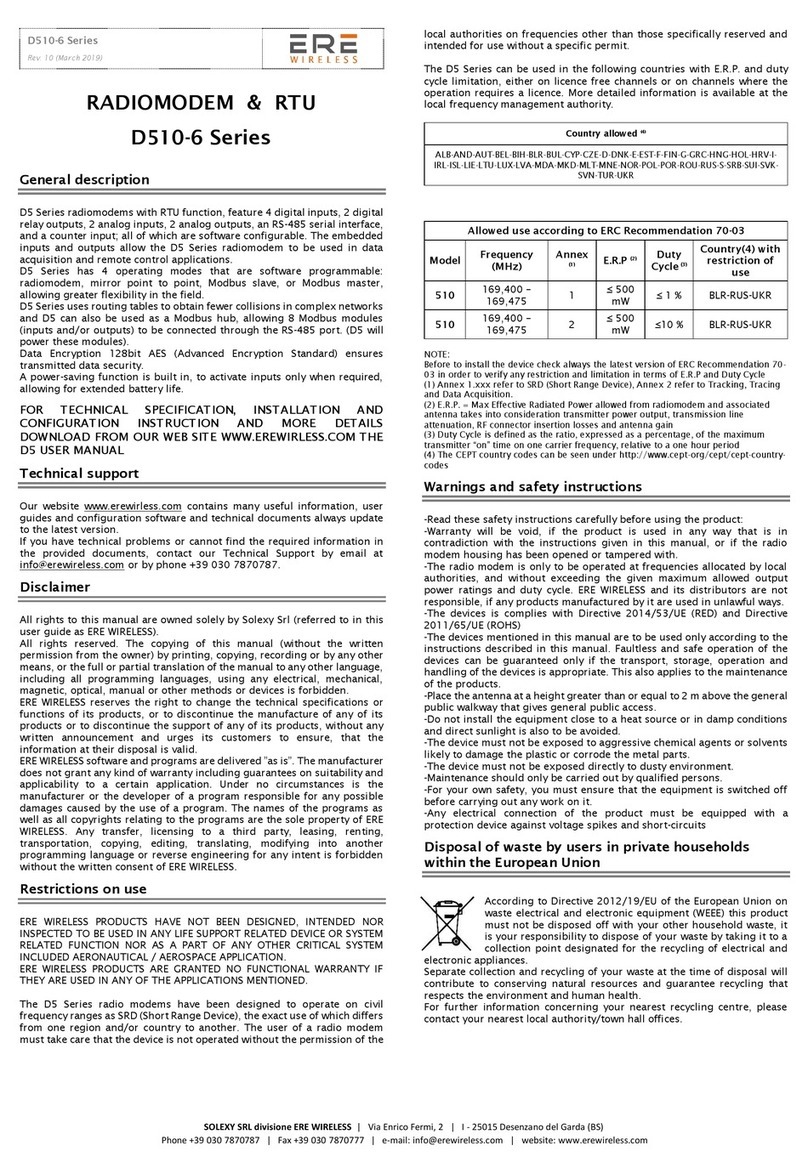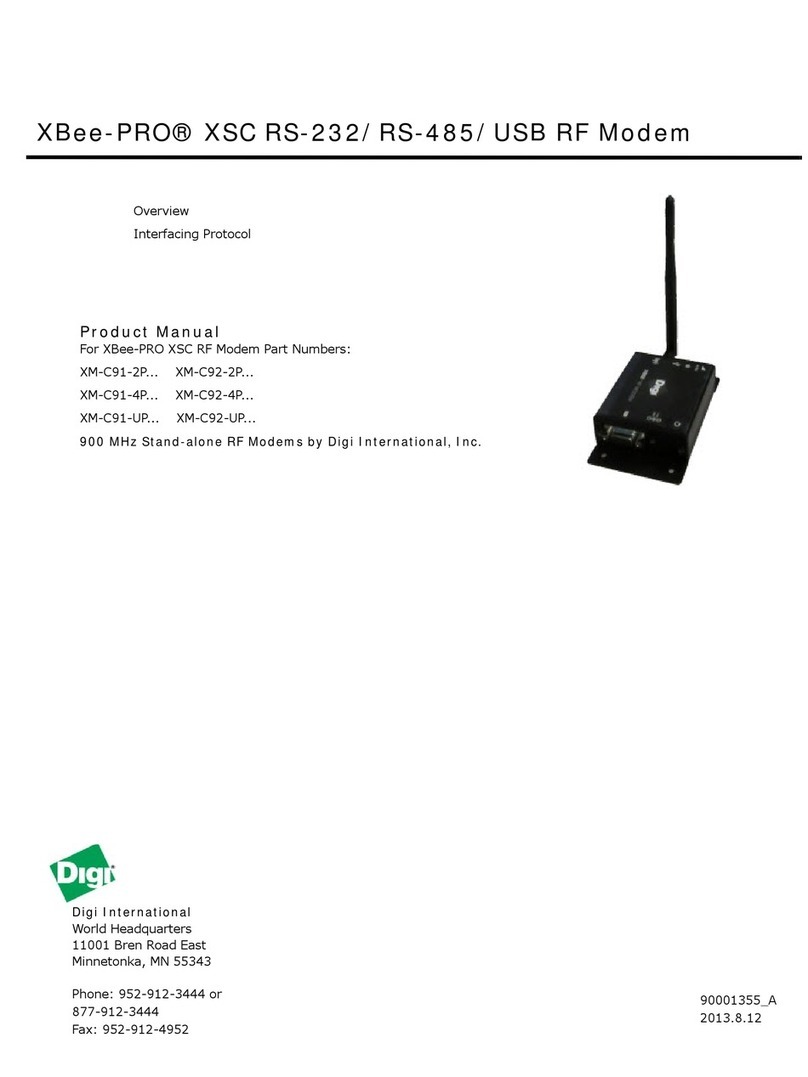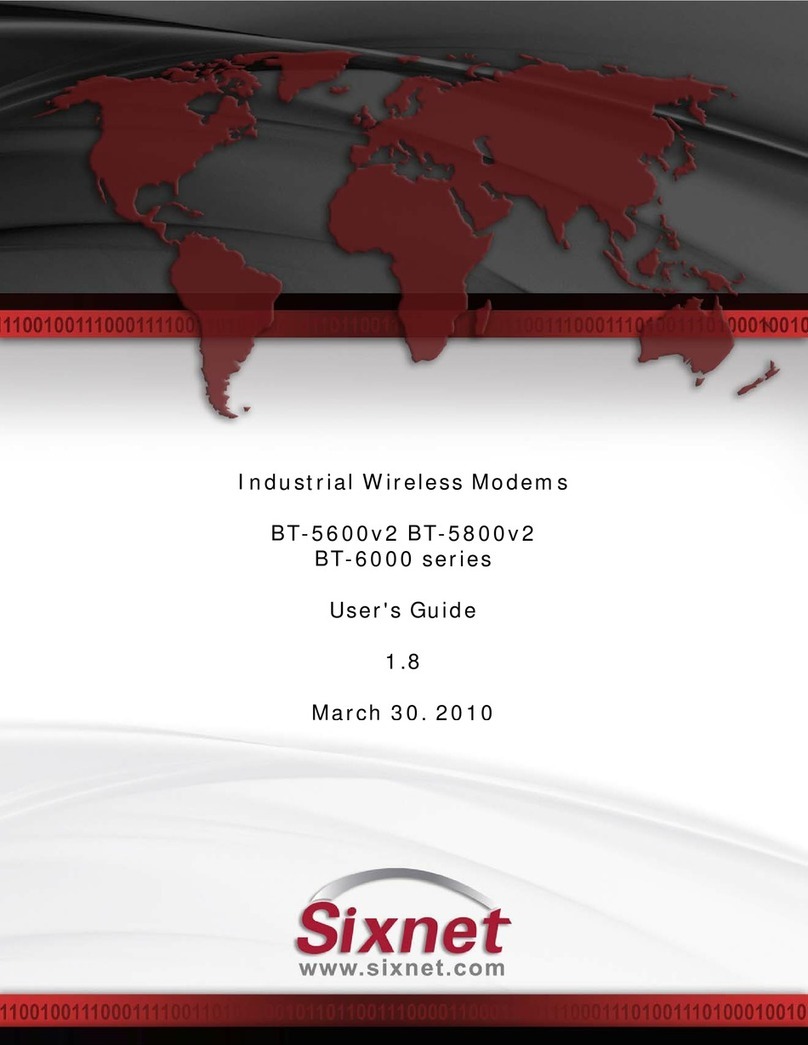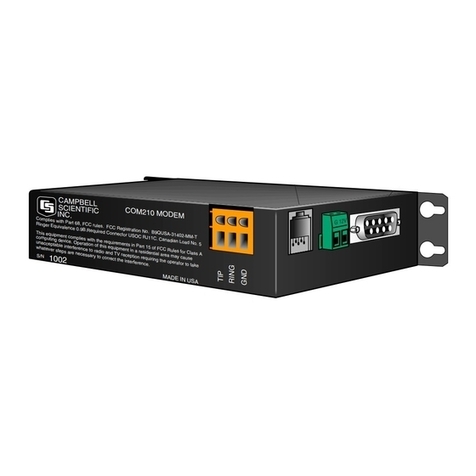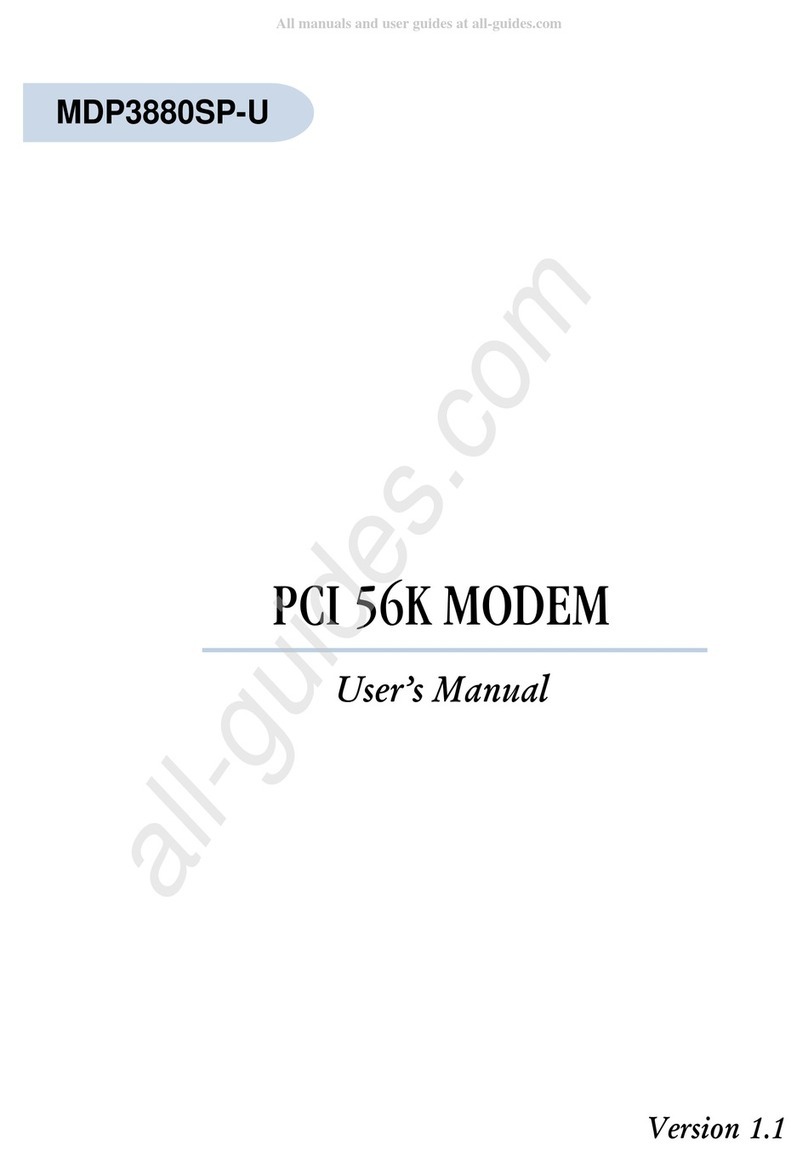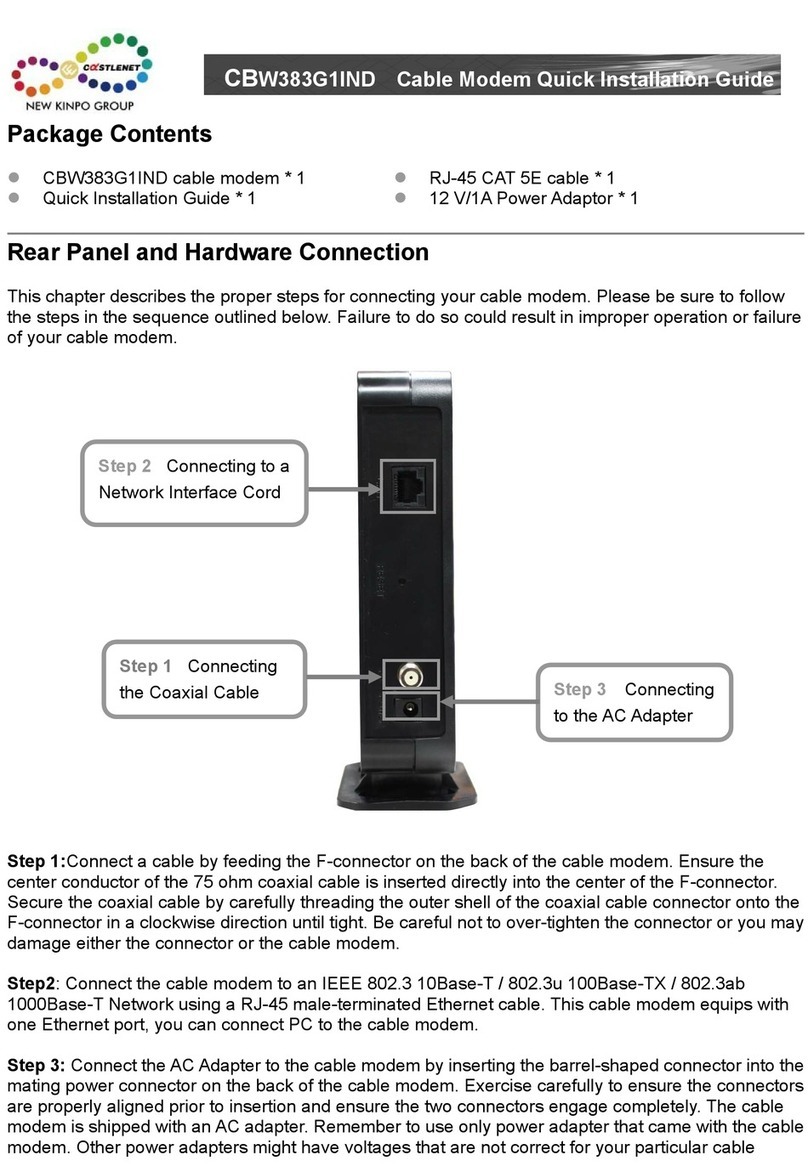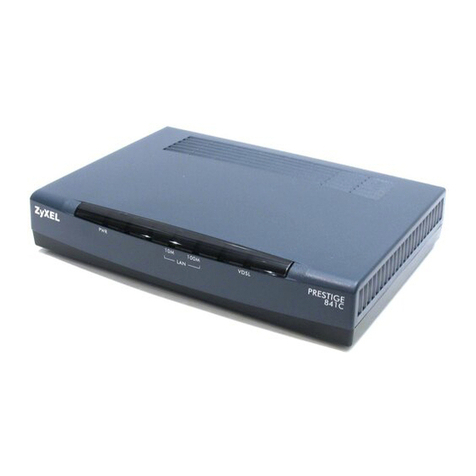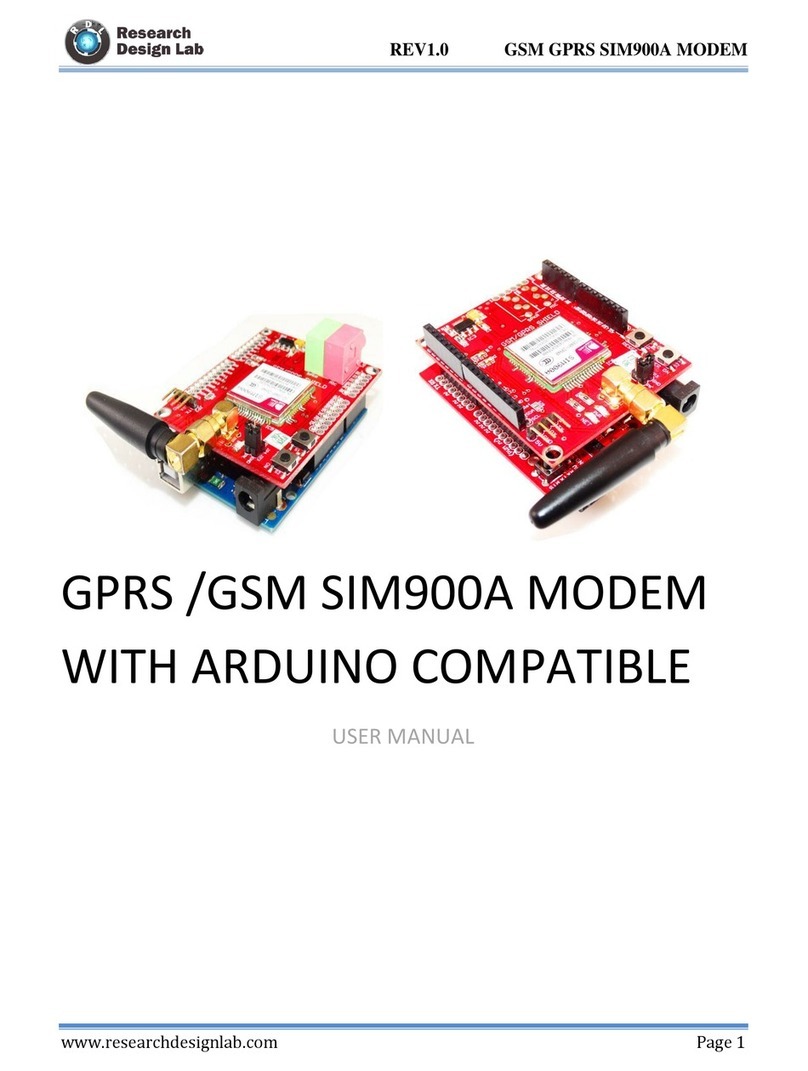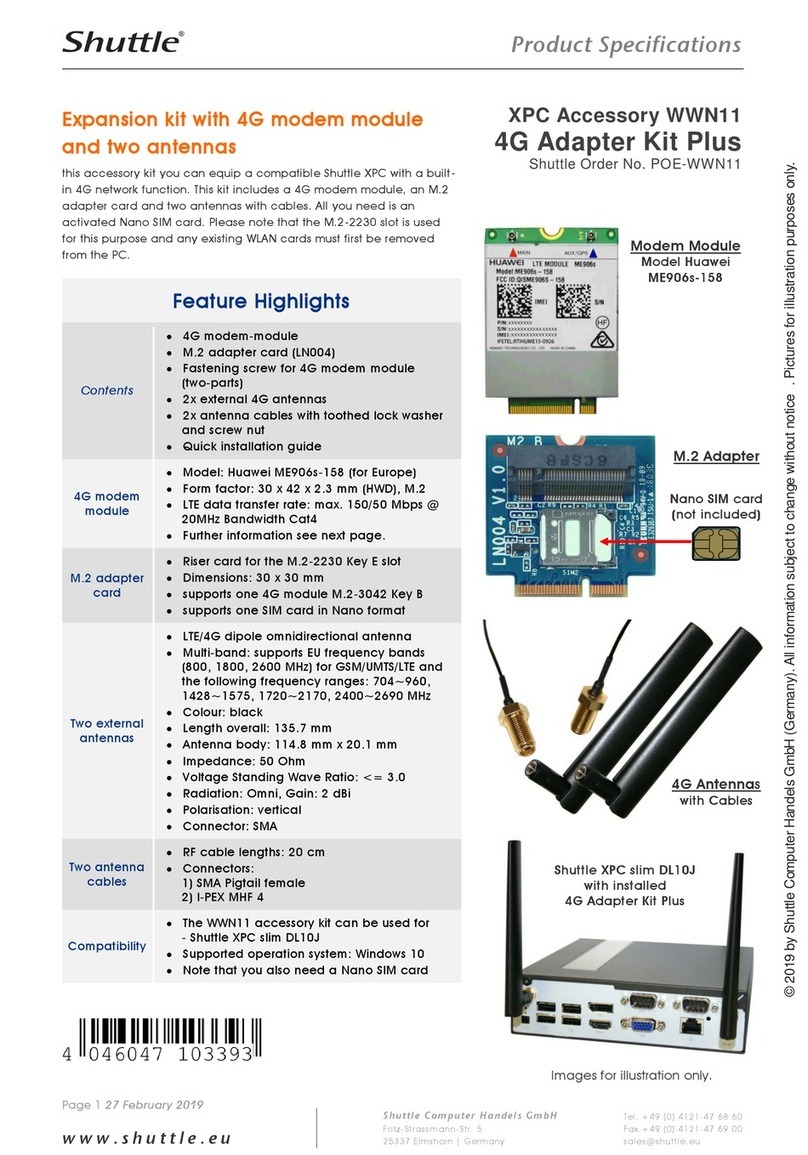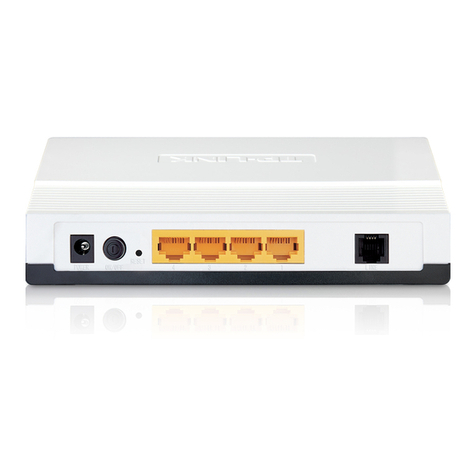ERE Wireless RADIOMODEM D510-E Series User manual

D510-E & D540-E Series
User Guide, Rev. 04 (December 2017)
RADIOMODEM
D510-E Series
D540-E Series
Via Enrico Fermi, 2 | I - 25015 Desenzano del Garda (BS)
Tele ono +39 0385 48139 | Fax +39 0385 40288
e-mail:l in [email protected]
sito web: www.erewireless.com
1

D510-E & D540-E Series
User Guide, Rev. 04 (December 2017)
Table of contents
!!
"
!#" $
%&%' (
)% " *
!+% ! + !,*
-!" .
" /0
1#) " /
!
"###$
%#!&
%#'(
!)
%!$
,"% $
*+,-
"#+&
23 .
./01"2
./01*.34"5"(
2

D510-E & D540-E Series
User Guide, Rev. 04 (December 2017)
Disclaimer
All rights to this manual are owned solely by SOLEXY Srl (referred to in this user guide as ERE WIRELESS)
All rights reserved The copying of this manual (without the written permission from the owner) by printing,
copying, recording or by any other means, or the full or partial translation of the manual to any other
language, including all programming languages, using any electrical, mechanical, magnetic, optical, manual
or other methods or devices is forbidden
ERE WIRELESS reserves the right to change the technical specifications or functions of its products, or to
discontinue the manufacture of any of its products or to discontinue the support of any of its products, without
any written announcement and urges its customers to ensure, that the information at their disposal is valid
ERE WIRELESS software and programs are delivered ”as is” The manufacturer does not grant any kind of
warranty including guarantees on suitability and applicability to a certain application Under no circumstances
is the manufacturer or the developer of a program responsible for any possible damages caused by the use
of a program The names of the programs as well as all copyrights relating to the programs are the sole
property of ERE WIRELESS Any transfer, licensing to a third party, leasing, renting, transportation, copying,
editing, translating, modifying into another programming language or reverse engineering for any intent is
forbidden without the written consent of ERE WIRELESS
Technical su ort
Our website contains many useful information, user guides and configuration software and technical
documents always update to the latest version
If you have technical problems or cannot find the required information in the provided documents, contact our
Technical Support by email at or by phone +39 0385 48139
Restrictions on use
ERE WIRELESS PRODUCTS HAVE NOT BEEN DESIGNED, INTENDED NOR INSPECTED TO BE USED
IN ANY LIFE SUPPORT RELATED DEVICE OR SYSTEM RELATED FUNCTION NOR AS A PART OF
ANY OTHER CRITICAL SYSTEM INCLUDED AERONAUTICAL / AEROSPACE APPLICATION
ERE WIRELSS PRODUCTS ARE GRANTED NO FUNCTIONAL WARRANTY IF THEY ARE USED IN ANY
OF THE APPLICATIONS MENTIONED
ERE D5 Series radio modems have been designed to operate on frequency ranges as SRD (Short Range
Device), the exact use of which differs from one region and/or country to another The user of a radio modem
must take care that the device is not operated without the permission of the local authorities on frequencies
other than those specifically reserved and intended for use without a specific permit
ERE D5 Series can be used in the following countries with E R P and duty cycle limitation, either on licence
free channels or on channels where the operation requires a licence More detailed information is available
at the local frequency management authority
Country allowed (4)
ALB-AND-AUT-BEL-BIH-BLR-BUL-CYP-CZE-D-DNK-E-EST-F-FIN-G-GRC-HNG-HOL-HRV-I-IRL-ISL-
LIE-LTU-LUX-LVA-MDA-MKD-MLT-MNE-NOR-POL-POR-ROU-RUS-S-SRB-SUI-SVK-SVN-TUR-UKR
3

D510-E & D540-E Series
User Guide, Rev. 04 (December 2017)
Allowed use according to ERC Recommendation 70-03
Model Frequency (MHz) Annex (1) E.R.P (2) Duty Cycle (3) Country(4) with
restriction of use
510 169,400 – 169,475 1 ≤ 500 mW ≤ 1 % BLR-RUS-UKR
510 169,400 – 169,475 2 ≤ 500 mW ≤10 % BLR-RUS-UKR
540 863,000 – 870,000 1≤ 25 mW ≤ 0 1 % BLR-GRC-NOR-RUS-S
540 868,000 – 868,600 1≤ 25 mW ≤ 1 % RUS
540 868,700 – 869,200 1≤ 25 mW ≤ 0 1 % BLR-UKR
540 869,400 – 869,650 1≤ 500 mW ≤ 10 % BLR-RUS-UKR
540 869,700 – 870,000 1≤ 5,0 mW ≤ 100 % RUS-UKR
NOTE:
Before to install the device check always the latest version of ERC Recommendation 70-03 in order to verify any
restriction and limitation in terms of E R P and Duty Cycle
(1) Annex 1 xxx refer to SRD (Short Range Device), Annex 2 refer to Tracking, Tracing and Data Acquisition
(2) E R P = Max Effective Radiated Power allowed from radiomodem and associated antenna takes into consideration
transmitter power output, transmission line attenuation, RF connector insertion losses and antenna gain
(3) Duty Cycle is defined as the ratio, expressed as a percentage, of the maximum transmitter “on” time on one carrier
frequency, relative to a one hour period
(4) The CEPT country codes can be seen under http://www cept-org/cept/cept-country-codes
4

D510-E & D540-E Series
User Guide, Rev. 04 (December 2017)
Technical s ecification
O erating data
Label Description alue
VS (EXT) Power supply, voltage range 9,0 → 32 Vdc
PS (EXT) Max power max 5 W
I Rx Sleeping current (Power Off) 140 mA
PRF RF transmission power Level H 500 mW
Level M 150 mW
Level L 25 mW
RXSENS Receiver sensitivity ≤ -105 ± 3 dBm
RFMOD Modulation mode ***F1D
CH Canalization D510 12,5 – 25 – 50 kHz
D540 25 – 50 kHz
BR Radio Baud Rate on radio channel D510 4 800 – 9 600 – 19 200
bps
D540 9 600 – 19 200 bps
Buffer Memory buffer 1024 bytes
ZI/O ANT Antenna impedance 50 �
VDIG-INP LOW Voltage low level logic digital input ≤ 0,60 Vdc
VDIG-INP HIGH Voltage high level logic digital input ≥ 2,40 Vdc
Z DIG-INP Digital input impedence 2 k �
tDIG-INP↓/↑ Low / high level recognition time of digital inputs ≥ 85 / 750 msec
IA,B LINES Max current out at RS-485 serial port ± 60 mA
BR DTE Baud Rate serial port 1 200 → 57 600 bps
WARNING
Exceed the maximum o erating value below (continuous and/or tem orary) can damage the device
Maximum o erating data
Label Description alue
VS(EXT) Max power supply voltage 32 Vdc
V DIG-INP Digital input, max voltage ± 24 Vdc / 20Vac
VP RS-485 Max peak voltage at the ports A/B RS-485 (1) ± 32 Vdc
IO DIG-OUT Max Digital output rating 1 A@24Vdc
1 A@24Vac
I A,B LINES Max current out at the A/B RS-485 ± 200 mA
T OPERATING Operating temperature range -30°C +70 °C
T STORAGE Storage temperature range -40°C +85 °C
NOTE:
(1) Impulse time < 100 millisecond
Interfaccia Ethernet
Conformità IEEE802 3
Connessione RJ45
Trasmissione dati 10/100 Mbps Auto-Detection
DHCP Server, Client
Protocolli TCP/IP, Modbus RTU over TCP
Configurazione Web Server, Windows Utility
HP Auto-MDIX Supported
5

D510-E & D540-E Series
User Guide, Rev. 04 (December 2017)
Warranty - Liability of the Product
Supplier represents and warrants that products are manufactured in accordance with the applicable
specifications and are free from defects in materials and workmanship The warranty, valid for a period of 12
months of use, maximum 18 months from the date of delivery, shall not cover defects caused by accident,
Buyer’s negligence, improper use or maintenance or by any other reason beyond Supplier’s control
Buyer shall have 10 (ten) working days following receipt of products to inspect the products and to notify to
Supplier in writing any defects or non-compliance In the event that any shipment of products is not accepted
by Buyer due to any non-conformity with the specifications, or as a result of a cause occurred prior to
placement thereof with the carrier, Buyer shall, if so indicated in writing by the Supplier, promptly return some
samples or the full shipment that was rejected by Buyer at Buyer’s costs
Supplier, at its own discretion, shall, within a reasonable period, considering the entity of the complaint: (i)
send a replacement shipment of products conforming, or (ii) credit Buyer a sum equal to the value of the
defective or non-conforming products This warranty overwrites all legal warranties for defects and
compliance and exempts Supplier from any other responsibility for the supplied products; in particular, Buyer
shall not be entitled to any requests for compensation or price reductions
If one of the products sold by the Supplier to the Buyer is defective, the Buyer will send it, at its own
expense, at the headquarters of the Italian Supplier The product will be repaired or replaced by the Supplier,
at no costs to the Buyer
The Buyer will pay all the shipping costs for the product repaired or replaced and sent back to the Buyer
The Buyer will bear all costs related to disassembly, assembling and transportation of the product, and any
damage caused by the "machinery inactivity"
Supplier shall indemnify Buyer against any liability of the products claims asserted by third parties relating to
damages sustained as a result of a defective products In such case Supplier shall reimburse Buyer
exclusively within the limits, terms and conditions of the products liability insurance policy held by Supplier
Buyer shall not make any oral or written representations which vary from the specifications, operating
instructions, labels or representations given or made by Supplier with respect to the products If any liability
is incurred because of such varying representations, Buyer holds Supplier harmless with respect to any such
representations
In no event shall Supplier be liable for any indirect, incidental, exemplary or consequential damages,
including without limitation any claim for damages based on lost revenues or profits, however caused
In no event shall the Supplier be liable for any costs or damages arising from any act or omission of Buyer,
including, without limitation, relating to the modification, handling, storage and marketing of Products by
Buyer or to Buyer’s failure to provide its employees, agents and customers or other third parties with
adequate instruction as to the proper handling and use of Products
In this respect we hereby confirm that our products are not designed for nuclear applications neither for
aircraft/aerospace industries For the above mentioned applications both warranty and insurance coverage
do not apply
6

D510-E & D540-E Series
User Guide, Rev. 04 (December 2017)
Warnings and safety instructions
-Read these safety instructions carefully before using the product:
-Warranty will be void, if the product is used in any way that is in contradiction with the instructions given in
this manual, or if the radio modem housing has been opened or tampered with
-The radio modem is only to be operated at frequencies allocated by local authorities, and without exceeding
the given maximum allowed output power ratings and duty cycle ERE WIRELESS and its distributors are not
responsible, if any products manufactured by it are used in unlawful ways
-The devices is complies with Directive 2014/53/UE (RED) and Directive 2011/65/UE (ROHS)
-The devices mentioned in this manual are to be used only according to the instructions described in this
manual Faultless and safe operation of the devices can be guaranteed only if the transport, storage,
operation and handling of the devices is appropriate This also applies to the maintenance of the products
-Place the antenna at a height greater than or equal to 2 m above the general public walkway that gives
general public access
-Do not install the equipment close to a heat source or in damp conditions and direct sunlight is also to be
avoided
-The device must not be exposed to aggressive chemical agents or solvents likely to damage the plastic or
corrode the metal parts
-The device must not be exposed directly to dusty environment
-Maintenance should only be carried out by qualified persons
-For your own safety, you must ensure that the equipment is switched off before carrying out any work on it
-Any electrical connection of the product must be equipped with a protection device against voltage spikes
and short-circuits
Dis osal of waste by users in rivate households within the Euro ean Union
According to Directive 2012/19/EU of the European Union on waste electrical and
electronic equipment (WEEE) this product must not be disposed off with your other
household waste, it is your responsibility to dispose of your waste by taking it to a
collection point designated for the recycling of electrical and electronic appliances
Separate collection and recycling of your waste at the time of disposal will contribute
to conserving natural resources and guarantee recycling that respects the
environment and human health
For further information concerning your nearest recycling centre, please contact your
nearest local authority/town hall offices
7

D510-E & D540-E Series
User Guide, Rev. 04 (December 2017)
General descri tion
The D5/Ethernet series are radiomodem with 1 Ethernet port, 1 optically isolated digital inputs and 1 digital
relay outputs, an RS-232/485 serial interface, all of which are software configurable
The embedded inputs and outputs allow the D5/Ethernet Series radiomodem to be used in data acquisition
and remote control applications
D5/Ethernet Series has 4 operating modes that are software programmable: radiomodem, mirror point to
point, Modbus slave, or Modbus master, allowing greater flexibility in the field
D5/Ethernet Series uses routing tables to obtain fewer collisions in complex networks and D5/Ethernet can
also be used as a Modbus hub, allowing 8 Modbus modules (inputs and/or outputs) to be connected through
the RS-485 port ( D5/Ethernet will power these modules)
Data Encryption 128bit AES (Advanced Encryption Standard) ensures transmitted data security
A power-saving function is built in, to activate inputs only when required, allowing for extended battery life
Function available for each operating mode
Yes= you can choose and/or modify the function
No = the function doesn’t exist or is not enabled
Operating mode
Radio
modem
ModBus Standard ModBus Low
Energy Point-Point
Master Slave Master Slave Master Slave
Radio
Channel spacing Yes Yes Yes Yes Yes Yes Yes
RF channel Yes Yes Yes Yes Yes Yes Yes
Frequency Agility Yes Yes Yes Yes Yes Yes Yes
Listen Before Talk Yes Yes Yes No No No No
RF power Yes Yes Yes Yes Yes Yes Yes
Serial Port RS485
Bit Rate Yes Yes Yes Yes Yes Yes Yes
Parity bit Yes Yes Yes Yes Yes Yes Yes
DTX Time Yes Yes Yes Yes Yes Yes Yes
8

D510-E & D540-E Series
User Guide, Rev. 04 (December 2017)
Operating mode
Radio
modem
ModBus Standard ModBus Low
Energy Point-Point
Master Slave Master Slave Master Slave
Auxiliary
Safety option Yes Yes Yes Yes Yes Yes Yes
Contact of relè selectable
NC/NO No No No No No Yes Yes
In ut & Out ut
Digital inputs Yes
(n° 1) No Yes
(n° 1)
Yes
(n° 1) No Yes
(n° 1)
Yes
(n° 1)
Digital outputs Yes
(n° 1) No Yes
(n° 1)
Yes
(n° 1) No Yes
(n° 1)
Yes
(n° 1)
Data
AES encrytption Yes Yes Yes Yes Yes No No
Routing Table Yes, 1
section
Yes, 255
section No No No Yes, 1
section
Yes, 1
Yes
Broadcasting Yes No No No No No No
Address from DTE Yes No No No No No No
Address to DTE Yes No No No No No No
Rx address for Tx Yes No No No No No No
Request of ACK Yes No No No No No No
Set number of retries Yes
(max 255) No No No No Yes No
NAK to DTE Yes No No No No No No
Other
Diagnostic Yes No No No
(always
active)
No
(always
active)
No Yes
Power Save No No No No No No No
Link Test Yes No No No No No No
Network check Yes Yes Yes Yes Yes Yes Yes
9

D510-E & D540-E Series
User Guide, Rev. 04 (December 2017)
Installation
Mechanical
The device must be installed in a location that is sufficiently ventilated so that there is no risk of internal
heating Place the device against a flat, firm and stable surface It is not recommendable to install the radio
modem on a strongly vibrating surface Suitable dampening and/or isolation materials should be used in
cases where the installation surface will be subjected to vibration
Electrical (wiring)
To prevent damage both the radio modem and any terminal devices must always be switched OFF before
connecting or disconnecting the serial connection cable It should be ascertained that different devices used
have the same ground potential Before connecting any power cables the output voltage of the power supply
should be checked
The product has no disconnecting device An external disconnecting device must be installed This must be
close to the equipment
Provide an adequate termination resistance on the RS485 serial line
To by supplied by class II (LPS) certified AC/DC adaptor
Connettore JP1
PIN Label Description
1 “A” RS-485 (line A)
2 Ground (GND)
3 “B” RS-485 (line B)
4Digital output normally open (NO)
5
6Optoisolated digital input
7
8 Ground (GND)
9 9-32V 0,7A Power Supply(9 - 32 VDC, 0 7A)
10
JP1
JP2

D510-E & D540-E Series
User Guide, Rev. 04 (December 2017)
Connettore JP2
PIN Label Description
RJ45 Ethernet port 10/100 Mbps Auto-Detection
Antenna
The device’s antenna must be free and at least 10 cm away from any conducting material When the
antenna is installed outside, it is essential to connect the cable screen to the building’s earth We
recommend using lightning protection The protection kit chosen must permit the coaxial cable to be earthed
(eg: coaxial lightning arrester with earthing of the cable at different places on the antenna at the base of
pylons and at the entry, or just before entering the premises)
11

D510-E & D540-E Series
User Guide, Rev. 04 (December 2017)
Configuration
The configuration of the radiomodem can be carried out via Ethernet through the available LAN port using
the integrated web server or using the ERE configuration software
System requirements
Operating system: Windows 98 SE, Windows ME, Windows2000, Windows XP, Windows Vista, Windows 7,
Windows 8, Windows 10
Screen : minimum resolution 800 x 600
Configuration via Ethernet ort
Connect the radio modem using a UTP cable to the computer and open the configuration page via the web
browser at the IP address 192.168.1.100 or htt ://ere-d5-eth2:
Type the following username and password:
Username : admin
Password : admin
If the module is connected and powered up properly, radio parameters will be read automatically
The starting IP address is always 192 168 1 100 This, however, can be different if assigned by the DHCP
server or if assigned by the user at a later configuration stage
12

D510-E & D540-E Series
User Guide, Rev. 04 (December 2017)
After reading, the following information will be indicated:
Model
Module band (VHF or UHF)
Firmware version
Radiomodem IP address
N.B. If the radiomodem had already been used with different IP, it is ossible to reset the default
address to the ower-u by kee ing the configuration button (CFG) ressed for more than 3
seconds.
Click on CONFIGURE and follow the instructions on the web pages, more information about the individual
items are available by clicking on the HELP button
13

D510-E & D540-E Series
User Guide, Rev. 04 (December 2017)
Radiomodem Model
Particular attention must be paid to this option, which requires to select the radiomodem model to be set up
Select a model from those available.
If you choose the D5 model with no Ethernet port, the Ethernet model D5 will function as a bridge,
connecting the RS485 serial ports, on both radiomodems, making it possible also to configure the D5 model
via Ethernet
IThe correct RS485 connection between the two models is achieved by connecting the respective lines,
namely line 'A' with 'A' and line 'B' with 'B' Not necessarily the two different models must both be of the same
VHF or UHF band
N.B. If you return to the home page (Home) from other pages, wait a few seconds before clicking on other
options This operation is necessary to enable the automatic and complete reading of the data that are
present on the module Otherwise you may get invalid results. Wait until you will see the band of the
radio modem and firmware version.
14

D510-E & D540-E Series
User Guide, Rev. 04 (December 2017)
15

D510-E & D540-E Series
User Guide, Rev. 04 (December 2017)
Click on CHANGE PARAMETERS to change the parameters set by default
16

D510-E & D540-E Series
User Guide, Rev. 04 (December 2017)
Configuration of radio arameters
Depending on the bandwidth of the radiomodem, the following window options will be shown:
Sub-band
Always complying with regulations, and ONLY for the UHF radiomodem, you can select the part of the band
in which you want to work There are 4 sub-bands that differ in permissible power and duty-cycle
Canalization
For the VHF model up to 3 different canalizations can be selected: 12.5, 25, 50 kHz
Depending on the choice, also the speed of transmission and the preset usable frequencies will vary
(respectively 4800, 9600 and 19200 bps) To select them, tick the appropriate box Gray boxes represent
frequencies that are not available for that canalization
The transmission is possible on single frequency or in agility mode With channel 12 5 kHz in agility only 3
frequencies with a distance of at least 25 kHz are selectable With 25 kHz channel in agility you can select a
maximum of 2 frequencies with a distance of 50 kHz
In the channel 50 kHz only one transmission frequency is possible On the contrary, for the UHF model 2
types of canalizations are possible: 25 or 50 kHz The speed of transmission is in this case either 9600 or
19200 bps
With the SOLO UHF radio modem you can manually set the baud rate choosing, of course, a value
compatible with the previously selected sub-band By default the first acceptable lowest frequency is set that
is visible in the frequency box for the selected sub-band If the value entered manually is not valid, when you
click on the' Continue 'button the error window appears and the box containing the error will blink red until
you re-enter an acceptable rate At this stage it is recommended not to change sub-band to prevent the
loading of default values that are not allowed for a possible frequency in agility mode Even in the UHF
model channeled kHz and 50 a single transmission frequency is possible
N.B.: The frequency value entered manually is always approximated to the next valid frequency
(eg 869 430 ---> 869 425 MHz with 25 kHz canalization) This rule is valid also for the second frequency in
agility mode
17

D510-E & D540-E Series
User Guide, Rev. 04 (December 2017)
Power
In the radiomodems you can select 3 different levels of transmission ower.
LOW: corresponds to a level of 25 mW (+14 dBm)
MEDIUM: corresponds to a level of 150 mW (+21 8 dBm)
HIGH: corresponds to a level of 500 mW (+27 dBm)
N.B.: In UHF radiomodems the maximum power level is possible only in the sub-band G 1 3 In the other
sub-bands you can select the medium power but it is up to the user to make sure that, in any sub-band, the
effective radiated power (E R P) does not exceed the limits permitted by law!
Function AFA (Automatic Frequency Agility)
This radiomodem function allows to avoid interference in the data transmission, that is to say, the
radiomodem, before transmitting on a precise frequency, ensures that the channel is free; otherwise it moves
to another frequency, set as described above in the “canalization” paragraph The function is enabled by
checking the initially empty box In the UHF radiomodem, at the time of box selection, the frame to set the
second frequency agility appears If the frequency is not included in the specified sub-band, an error
message appears and the frame containing the wrong value flashes red The user is invited to enter a valid
value, otherwise you can’t continue with the other settings
With 50 kHz canalization in this band, agility it not allowed because you can broadcast only on a single
channel In VHF radiomodems, on the contrary, agility frequencies are preset: just tick the relevant empty
box remembering the rule not to select adjacent boxes With 50 kHz canalization only a transmission
frequency centered in the band is possible The agility is not possible
Function LBT (Listen Before Talk o Listen Before Transmit)
It is often used in combination with the AFA function and allows to monitor if the chosen channel is free
before starting to transmit. In both UHF and VHF models, the LBT function is selected by checking the
empty box
When the LBT function is activated, the radiomodem counts the seconds of transmission ON-AIR in order to
respect the limits imposed by the EN300 220-1 standard of 100 seconds of maximum transmission allowed
in the period of one hour After 100 seconds of transmission, the radiomodem waits for the time to elapse
before allowing further transmissions
18

D510-E & D540-E Series
User Guide, Rev. 04 (December 2017)
Configuration of data flow
Operating mode
Mirror
In Mirror mode, the status of the digital input is replicated respectively on the digital output of a remote unit
and vice versa In this operating mode, data communication is not allowed The mirror mode can only work
between two radiomodem units (point to point) and can use digipeaters (up to 8) to extend the route of the
radio link The initiative of the transmission is always taken by the master unit and it is triggered by two
different events:
1) The change of state of the Master’s digital
2) The expiration of the timer dedicated to the periodic sending of data (cycle update)
19

D510-E & D540-E Series
User Guide, Rev. 04 (December 2017)
On the Slave unit, every time a packet is received, the diagnostic parameters are sent over the serial line
The sent parameters are:
1) Status of digital input and digital output of the Master unit
2) RSSI value related to the last packet received by the Master unit
In the Slave unit you can also read the diagnostic parameters at any time by sending the command "at?" or
"AT? to the serial port The radio modem will respond with the parameters described above with addition of
the value of the elapsed time since the reception of the last packet transmitted by the Master
Modbus Low Energy
In this modality the network is composed of one Slave unit and one or more (up to 16) Master units The
Slave unit is connected to a PC (or PLC) on which there is a running SCADA software The slave device is
always in reception, it never takes the initiative of the transmission and transmits only in response to a
packet received from a Master unit The Master units send a packet to the Slave unit using the modbus RTU
Protocol The function "Write multiple registers (function code 0x10) is used
The transmission of the Master units is triggered by two events:
1) The expiration of the timer dedicated to the periodical sending;
2) A change in any of the four digital inputs on the Master radiomodem
On each Master device, it is possible to connect, by the RS485 interface, an external Modbus node (Modbus
device that can read digital or analog inputs) in order to extend the number of monitored signals
Note: You cannot use the digital inputs of an external modbus node to trigger the transmission on the
radiomodem
In the Master unit, when a transmission is triggered, the value of the digital and analog inputs is first
acquired, the external node (if present) is read, then the radio modem sends the packet consisting of the
collected data
The slave device receives the packet, controls it, and if there are no errors, it sends the data (payload) to the
SCADA application via the RS485 interface or Ethernet (protocol Modbus over TCP) At this point the
SCADA software, connected to the Slave radiomodem, sends the response packet, which is transmitted
back to the Master unit At the end of the communication, the Master unit returns in sleep mode, waiting for a
new transmission event
Modbus
This mode of operation provides one Master unit (star centre) and one or more slave units The Master unit
must be connected via the RS485 interface to a PC (or PLC) on which a SCADA application is running,
which uses the Modbus RTU communication protocol The SCADA application is the heart of the system and
has the task to read and/or write the parameters of the different nodes of the network using the Modbus
protocol The Master radiomodem, connected to the SCADA, uses the radio link to transmit the packets
received from the serial line The required addressing is realised by the use of an internal routing table To
do this the Master radiomodem evaluates the first byte of the received Modbus packet, which, in the Modbus
protocol, corresponds to the address of the node which you want to communicate with Each node address
(1 to 254) may be associated with an independent radio path
All radio modems in the network (both Masters and Slaves) must be configured with an unique address (the
"Its address" field) The routing table is used to indicate the path of the packet radio, in this way, the packet
arrives to the target radiomodem directly or via all the interested digipeaters In the routing table, the node
address number 255 is reserved for the broadcasting Modbus acket. In this case, the Master
radiomodem, when it receives a packet with address zero (packet broadcasting type) from the SCADA
application, uses the node number 255 of the routing table to route properly the radio packet The
broadcasting mode cannot be implemented if there is a radio modem unit that cannot communicate with all
the other units of the network, because in this case one or more units would not receive the broadcasting
packet This is the case of a network geographically widespread in mountainous areas or where there are
many obstacles
20
This manual suits for next models
1
Table of contents
Other ERE Wireless Modem manuals
Popular Modem manuals by other brands

NAL RESEARCH CORPORATION
NAL RESEARCH CORPORATION A3LA-R user guide
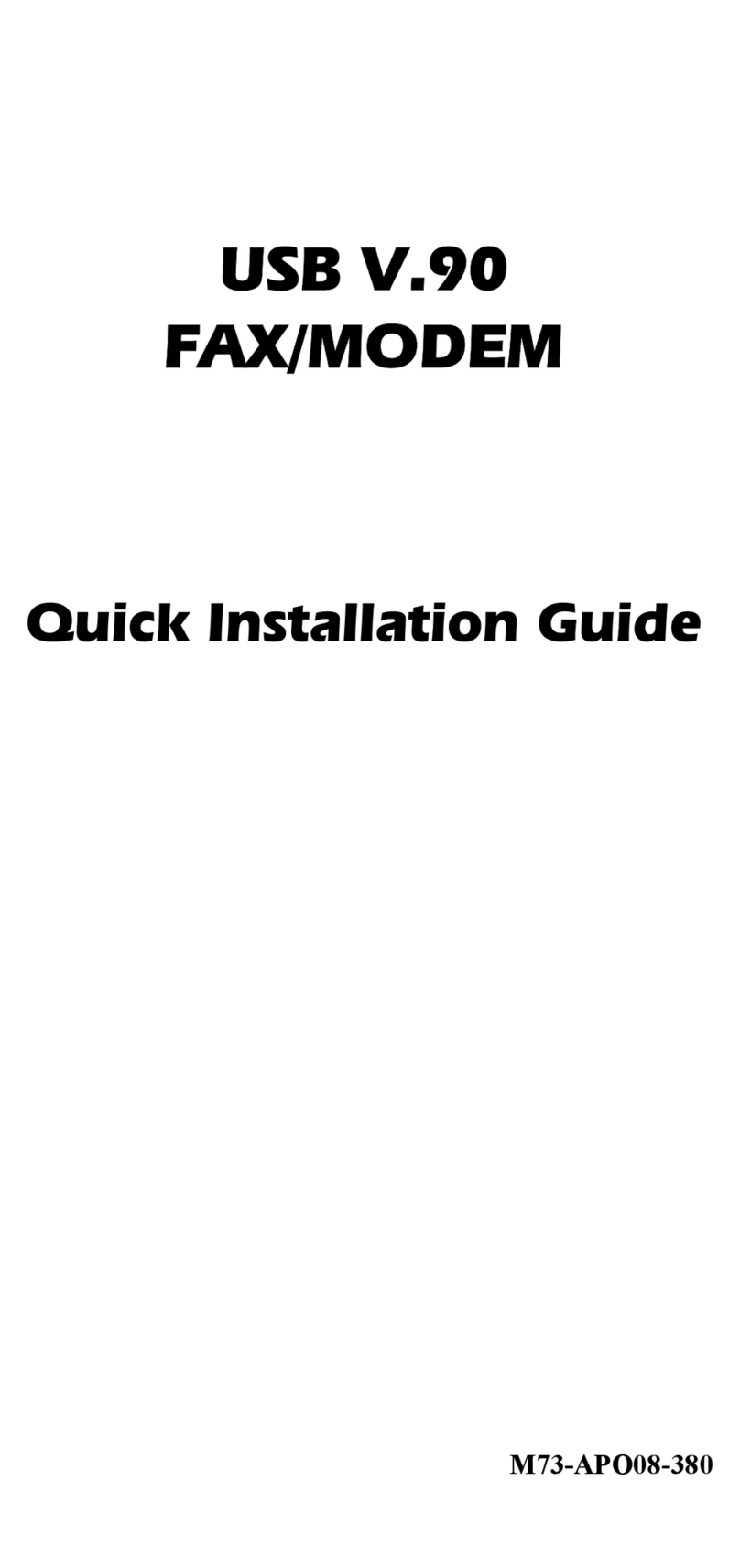
Abocom
Abocom USM560 Quick installation guide

Westermo
Westermo TD-29 AC installation manual
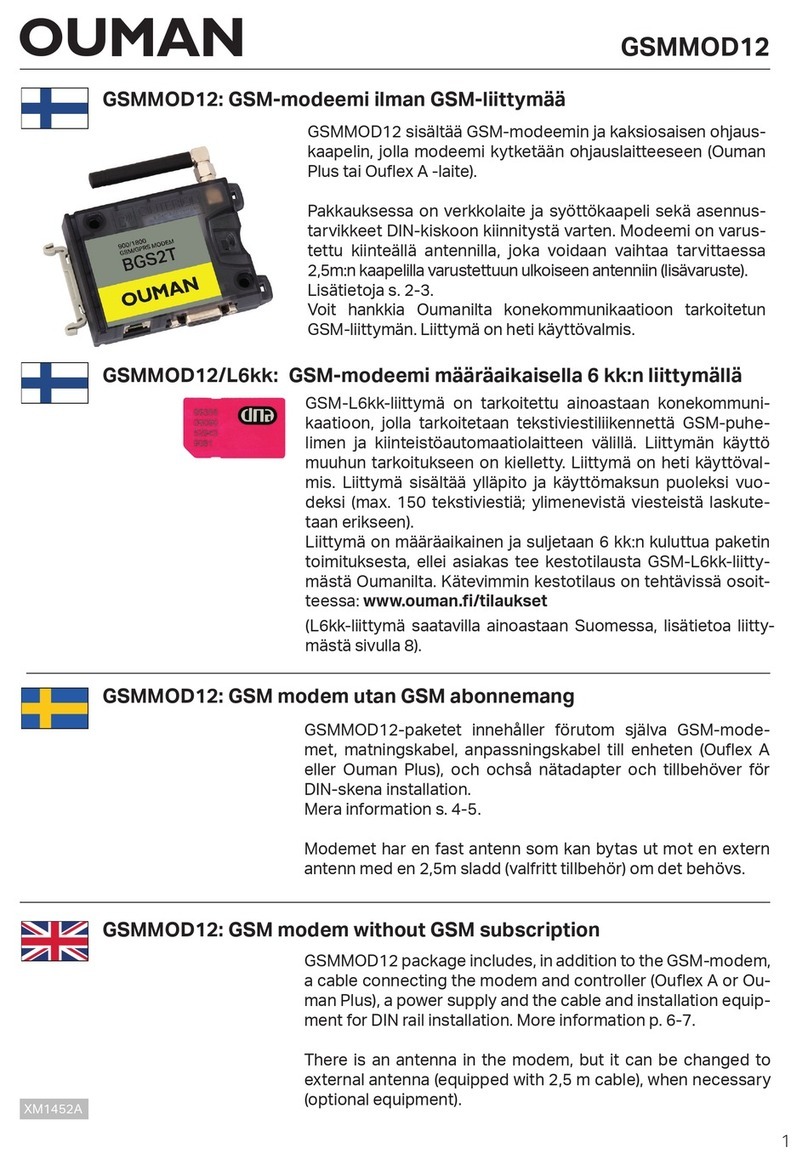
OUMAN
OUMAN GSMMOD12 quick start guide

Atlantis Land
Atlantis Land Web Runner 56K V.92 quick start guide
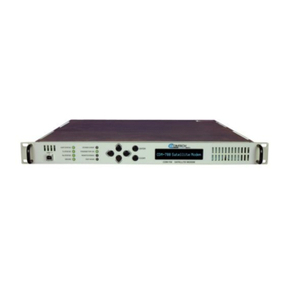
Comtech EF Data
Comtech EF Data CDM-700 Installation and operation manual
